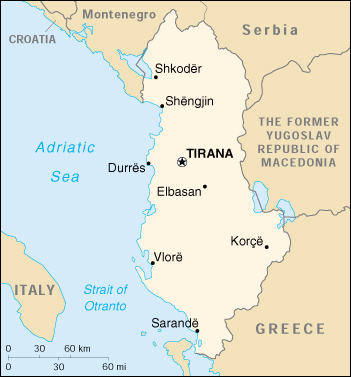
- Lage
- Balkanhalbinsel zwischen Serbien, Montengro und Griechenland. Im Westen liegt es mit einer Kstenlänge von 475 km am Adriatischen und am Ionischen Meer.
- Fläche
- gesamt: 28 748 qkm
- Land
- 27 398 qkm
- Wasser
- 1 350 qkm
- Landesgrenzen
- gesamt: 720 km
- Grenzstaaten
- Griechenland 282 km, ehemalige jugoslawische Republik Mazedonien 151 km, Jugoslawien 287 km (Serbien 114 km, Montenegro 173); Kste 362 km
|
Daten des Statistischen Bundesamtes |
|||
| Bevölkerung | 3,1 | Mill. | 2001 |
| Fläche | 28748 | qkm | 2001 |
| Bevölkerungsdichte | 107 | Einw. je qkm | 2001 |
| Arbeitslosenquote | 18,0 | % | 1999 |
| Bruttoinlandsprodukt (BIP) | 3752 | Mill.US-$ | 2000 |
| Jährliches BIP-Wachstum (real) | 7,8 | % | 2000 |
| BIP je Einwohner (real) | 899 | US-$ | 2000 |
| Inflationsrate | 0,1 | % | 2000 |
| Importe | 1091 | Mill.US-$ | 2000 |
| Exporte | 261 | Mill.US-$ | 2000 |
| Saldo der Im- und Exporte | -829 | Mill.US-$ | 2000 |
| PKW-Dichte | 37 | je 1000 Einw. | 2000 |
| Personal-Computer | 10 | je 1000 Einw. | 2001 |
- Staatsform
- Republik mit einem pluralistischem Parteiensystem. Das Staatsoberhaupt (Präsident) wird vom Parlament gewählt (5 Jahre, eimalige Wiederwahl möglich). Höchstes Organ der Exekutive ist der Ministerrat. Der Ministerpräsident ist der Vorsitzende des Minsterrates. Dieser ernennt die Minister, die vom Präsidenten bestätigt werden mssen. Das Parlament hat 140 Sitze, wovon 100 durch Diretktwahlen in Wahlkreisen besetzt werden und 40 von den Parteien entsprechend dem Wahlergebnis.
- Verwaltungsstruktur
- Albanien ist in 12 Präfekturen, 36 Bezirke, 43 Städte und 310 Gemeinden aufgegliedert. Die Brgermeister sowie die Gemeinde- und Bezirksräte werden direkt gewählt.
- Hauptstadt
- Tirana (ca. 650 000 EW)
- Städte
- Tirana, Hauptstadt, 650.000 EW; Durres (Durazzo), Haupthafen, 125.000 EW; Elbasan 101.000 EW; Shkoder 81.000 EW; Küstenstädte in Sdalbanien: Vlore 88.000 EW; Saranda 16.400 EW
- Klima
- mediterranes Klima – nasse Winter und hei� und trockene Sommer, das Landesinnere ist khler, in den Gebirgslagen strenge Winter
- Landschaft
- 76% der Fläche Albaniens sind gebirgig, wobei die höchste Erhebung im Nordosten der Albanischen Alpen 2.751 m beträgt. Im Westen und im Zentrum Albaniens liegen Ebenen (24% der Fläche) mit Höhen um 200 m. Die drei größten Seen sind Shkodra, Ohri und Prespa. Die wichtigsten Flüsse sind Drini, Shkumbini und Vjosa, die alle in die Adria münden.









